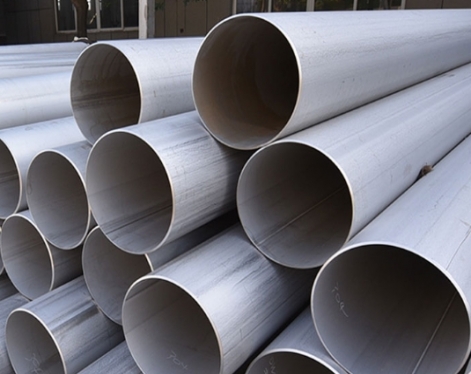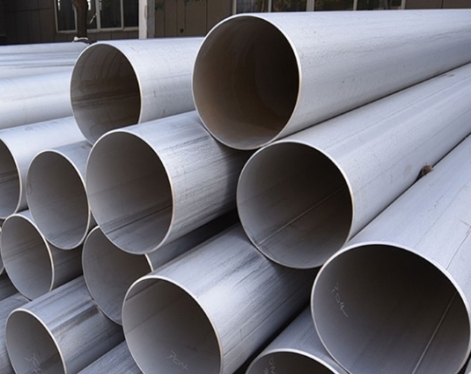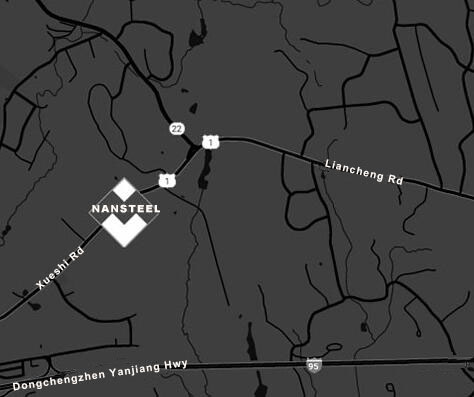What is Stainless Steel ERW Pipe?
Stainless steel erw pipe, also known as Electric Resistance Welding, is abbreviated as ERW. It is made of hot-rolled coil as raw material. After a series of processes such as uncoiling, leveling, and forming, the edges of the steel strip are welded together through the resistance welding process to form a straight seam steel pipe.
Resistance welding uses the resistance heat generated by electric current passing through the weldment and the contact point to locally heat the weldment to a plastic or molten state, while applying pressure to connect the weldments together. This welding method has the characteristics of high production efficiency, low cost, material saving, and easy automation, and is widely used in various industrial sectors. In the field of transportation pipes, stainless steel erw pipes occupy an important position. They can be used to transport gas and liquid objects such as oil and natural gas, and can meet various high and low pressure requirements.
Basic parameters of stainless steel erw pipe
The common outer diameter range of stainless steel erw pipes is generally between 21.3-711.2mm. For example, the outer diameter of common building decoration pipes may be concentrated in 25-50mm. The outer diameter of industrial fluid delivery pipes may be around 100-300mm. In terms of wall thickness, it is usually around 0.5-20mm, with 1-6mm being the more commonly used range. Thin-walled tubes may be 0.5-2mm and are used for ordinary decoration and small equipment with low pressure requirements; thick-walled tubes are 5-20mm and are used in high-pressure environments such as oil and natural gas transportation.
The length can generally be 5.8 meters, 6 meters, or as long as 12 meters, and can even be produced according to user needs. In terms of manufacturing standards, the commonly used ones are the American Society for Testing and Materials standards ASTM A53, ASTM A106, international standard ISO 3183, Chinese national standard GB/T 9711, etc. These standards have clear provisions on the dimensional accuracy, mechanical properties, chemical composition, and process quality of pipes.

Advantages of stainless steel erw pipe
1. Significant cost advantage
The production process of stainless steel erw pipe is relatively simple, with fast forming and welding speeds, which can achieve high production efficiency and greatly reduce time costs. At the same time, during the processing of the raw material steel strip, there is less waste of scraps, high utilization rate, and reduced material costs. Overall, its cost is lower than some seamless steel pipes and other similar pipes welded by complex processes, which saves money for engineering projects and has obvious advantages when used on a large scale.
Disadvantages of stainless steel erw pipe
Stainless steel erw pipe application industry
1. In the oil and gas industry, stainless steel erw pipes are often used in oil and gas transmission pipelines. In large-scale projects such as the West-East Gas Pipeline, stainless steel erw pipes are used for some pipelines.
2. In the construction field, stainless steel erw pipes are often used in building structure support and bridge construction. As a structural support component, the stainless steel erw pipe provides stable structural support for the building.
3. In the machinery manufacturing industry, stainless steel erw pipes are often used to manufacture mechanical parts, such as some pipes in automobile engines, transmission sleeves in industrial equipment, etc.
How to choose the right stainless steel erw pipe?
First, choose according to the use environment. If it is in a general indoor dry environment and the corrosion resistance requirement is not high, ordinary 304 stainless steel ERW pipe can be used
Secondly, determine the pipe diameter and wall thickness according to the pressure requirements. For water and gas transportation with lower pressure, smaller pipe diameter and thinner wall pipe can be selected; For high pressure transportation of oil, natural gas, etc., thick-walled pipes with appropriate diameters should be selected.
Thirdly, consider the budget. The price of stainless steel erw pipe varies due to different materials and specifications. Under the premise of meeting the use requirements, weigh the cost, compare the products of different manufacturers, and choose the one with the highest cost performance, avoiding blindly pursuing low prices and ignoring quality.
Read more: Introduction of Galvanized ERW Pipe, Gl ERW Pipe
Stainless steel erw pipe, also known as Electric Resistance Welding, is abbreviated as ERW. It is made of hot-rolled coil as raw material. After a series of processes such as uncoiling, leveling, and forming, the edges of the steel strip are welded together through the resistance welding process to form a straight seam steel pipe.
Resistance welding uses the resistance heat generated by electric current passing through the weldment and the contact point to locally heat the weldment to a plastic or molten state, while applying pressure to connect the weldments together. This welding method has the characteristics of high production efficiency, low cost, material saving, and easy automation, and is widely used in various industrial sectors. In the field of transportation pipes, stainless steel erw pipes occupy an important position. They can be used to transport gas and liquid objects such as oil and natural gas, and can meet various high and low pressure requirements.
Basic parameters of stainless steel erw pipe
The common outer diameter range of stainless steel erw pipes is generally between 21.3-711.2mm. For example, the outer diameter of common building decoration pipes may be concentrated in 25-50mm. The outer diameter of industrial fluid delivery pipes may be around 100-300mm. In terms of wall thickness, it is usually around 0.5-20mm, with 1-6mm being the more commonly used range. Thin-walled tubes may be 0.5-2mm and are used for ordinary decoration and small equipment with low pressure requirements; thick-walled tubes are 5-20mm and are used in high-pressure environments such as oil and natural gas transportation.
The length can generally be 5.8 meters, 6 meters, or as long as 12 meters, and can even be produced according to user needs. In terms of manufacturing standards, the commonly used ones are the American Society for Testing and Materials standards ASTM A53, ASTM A106, international standard ISO 3183, Chinese national standard GB/T 9711, etc. These standards have clear provisions on the dimensional accuracy, mechanical properties, chemical composition, and process quality of pipes.

Advantages of stainless steel erw pipe
1. Significant cost advantage
The production process of stainless steel erw pipe is relatively simple, with fast forming and welding speeds, which can achieve high production efficiency and greatly reduce time costs. At the same time, during the processing of the raw material steel strip, there is less waste of scraps, high utilization rate, and reduced material costs. Overall, its cost is lower than some seamless steel pipes and other similar pipes welded by complex processes, which saves money for engineering projects and has obvious advantages when used on a large scale.
2. Excellent processing performance
Because of its uniform material and stable internal structure, the incision is smooth during cutting, and there will be no problems such as edge collapse and deformation, and it can be accurately cut into the required length. During the bending process, cracks and wrinkles are not likely to occur, and it can be bent into various arcs to meet the needs of complex pipeline layouts. In terms of welding, it has good compatibility with various welding processes, high weld quality and strong sealing.3. High dimensional accuracy
During the production process, with the help of advanced forming equipment and precise welding process control, the dimensional deviations of the pipe's outer diameter, wall thickness and other dimensions can be controlled within a very small range. For example, the outer diameter tolerance can be controlled at ±0.5mm, and the wall thickness tolerance at ±0.2mm. This high precision allows the pipes to fit more closely during installation. In petrochemical pipeline installation, high-precision stainless steel erw pipes can ensure accurate pipeline connections, reduce the difficulty of sealing processing, and improve the overall stability and safety of the pipeline system.Disadvantages of stainless steel erw pipe
1. Slightly weaker corrosion resistance
Although the stainless steel erw pipe has a certain corrosion resistance, its surface treatment process is relatively simple, and only conventional passivation treatment is used to form a passivation film. In some highly corrosive environments, such as high-concentration acid and alkali solutions and coastal high-salt fog areas, this passivation film is difficult to resist erosion for a long time. Compared with pipes that have undergone special surface treatments, such as hot-dip galvanizing and nickel plating, it is more susceptible to corrosion and has problems such as rust and perforation, thus affecting the service life and the quality of the conveying medium.2. Limited pressure tolerance
Stainless steel erw pipe has certain limitations in withstanding high pressure. Due to its welding process characteristics, the strength at the weld may be slightly different from that of the parent material, which limits its application in ultra-high pressure environments. Generally speaking, when the working pressure exceeds a certain value, such as 10MPa, there may be risks of leakage, rupture, etc. at the weld.3. There are hidden dangers in welding
During the resistance welding process, the metallographic structure of the welding area is different from that of the base material, and the grain morphology and structure of the weld change. If the welding process parameters are not properly controlled, such as the welding current is too large or too small, the welding speed is unstable, etc., defects such as pores, slag inclusions, and incomplete penetration will occur in the weld. These defects will become stress concentration points, which may cause crack propagation when the pipe is subjected to pressure, vibration, and temperature changes, affecting the overall performance and safety.Stainless steel erw pipe application industry
1. In the oil and gas industry, stainless steel erw pipes are often used in oil and gas transmission pipelines. In large-scale projects such as the West-East Gas Pipeline, stainless steel erw pipes are used for some pipelines.
2. In the construction field, stainless steel erw pipes are often used in building structure support and bridge construction. As a structural support component, the stainless steel erw pipe provides stable structural support for the building.
3. In the machinery manufacturing industry, stainless steel erw pipes are often used to manufacture mechanical parts, such as some pipes in automobile engines, transmission sleeves in industrial equipment, etc.
How to choose the right stainless steel erw pipe?
First, choose according to the use environment. If it is in a general indoor dry environment and the corrosion resistance requirement is not high, ordinary 304 stainless steel ERW pipe can be used
Secondly, determine the pipe diameter and wall thickness according to the pressure requirements. For water and gas transportation with lower pressure, smaller pipe diameter and thinner wall pipe can be selected; For high pressure transportation of oil, natural gas, etc., thick-walled pipes with appropriate diameters should be selected.
Thirdly, consider the budget. The price of stainless steel erw pipe varies due to different materials and specifications. Under the premise of meeting the use requirements, weigh the cost, compare the products of different manufacturers, and choose the one with the highest cost performance, avoiding blindly pursuing low prices and ignoring quality.
Read more: Introduction of Galvanized ERW Pipe, Gl ERW Pipe









